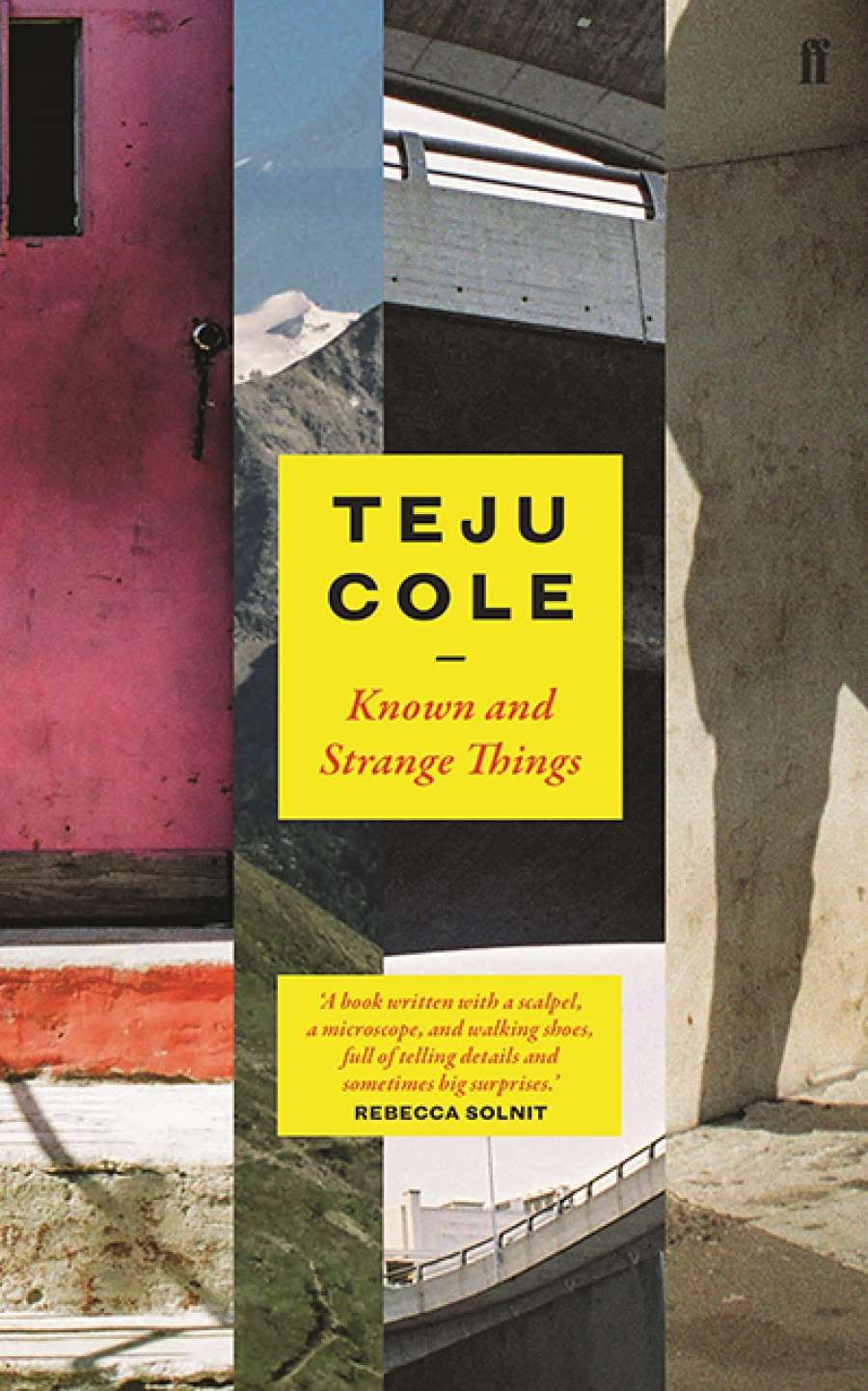
- Free Article: No
- Contents Category: Art
- Custom Article Title: Sujatha Fernandes reviews 'Known and Strange Things' by Teju Cole
- Custom Highlight Text:
In the opening piece of his book of collected essays, the novelist and photography critic Teju Cole feels briefly possessed by the spirit of James Baldwin who, like him, travelled outside the ...
- Book 1 Title: Known and Strange Things
- Book 1 Biblio: Allen & Unwin $29.99 pb, 385 pp, 9780571331390
The essays in Known and Strange Things are a meditation on the locations and people one encounters through travel, but Cole also recognises the ways in which our experiences of place are shaped by the media of music, art, literature, and, most profoundly for him, photography. The fictional nature of these media makes them no less able to conjure deep desires and attachments to place that may be more powerful than the direct experience of the place itself.
Enter Instagram. Section Two of the book, ‘Seeing Things’, grapples with the rise of social photography occasioned by the massive production of camera-phone images, the obsessive recording of every banality, and the manipulation of these photographs with filters on photo-sharing services like Instagram which use the same predictable algorithms, dank washes, and high contrasts. Nearly one trillion photos are taken every year of the same tired subjects like pretty girlfriends, meals, and sunsets. Cole turns a sardonic eye to the meaning of this trend, updating Walter Benjamin’s seminal essay on art in the age of mechanical reproduction to examine ‘art in the age of metastasized mechanical reproduction’. While acknowledging the complicated effects of this production, Cole laments the ‘constant exposure to illusion’ that lessens our sense of wonder at the world.
Even prize-winning photography and celebrated photojournalism have become inadequate to the task of addressing our present time and raising new questions. Cole says that the typical visuals of shocking and violent photos or viral videos may provide a jolt of outrage. Ultimately, the more they shock us, the more they enter our vocabulary of generic images that leave us in a state of what Susan Sontag calls ‘helpless voyeurism’: we are given very little sense of local context, and no indication of what to think or do in response.
In Known and Strange Things, Cole considers art’s potential to transcend the fakery and desensitisation generated by social media and photojournalism. Several of the essays explore the work of artists who seek alternative approaches, or who use social photography in subversive ways. In an essay entitled ‘Object Lesson’, Cole discusses a photo series by artist Glenna Gordon that looks at the things left behind by the Nigerian girls abducted by Boko Haram. One photograph of a blue blouse with the name ‘Hauwa Mutah’ written on the collar brings us into close contact with the lives of these girls in a context where the human victims are missing. Another project called Dronestagram, created by the computer artist James Bridle, presents undramatic and clinical Google satellite images of places where US drone strikes have occurred. These images, shared by the artist on Tumblr and Instagram, are of places where people died and, as Cole says, they ‘embed the grim promise that it’s not over’.
 Teju Cole (US Consulate General Munich/Wikimedia Commons)
Teju Cole (US Consulate General Munich/Wikimedia Commons)
In the third, forthright section of the book, Cole deals a forceful blow at humanitarianism as a growth industry, name-checking economist Jeffrey Sachs, Times columnist Nicholas Kristof, Oprah Winfrey, and TED. As a novelist, Cole says he is sensitive to the power of narrative in projecting ‘white fantasies of conquest and heroism’. In contrast to a tendency to blame awful warlords for problems of governance in the global south, or the need for white saviours to make issues palatable to Western audiences, Cole is concerned with the drive for oil and profits that sits at the heart of American foreign policy. Humanitarian disaster is a product of larger disasters like militarisation, agricultural policy, resource extraction, and US backing of corrupt and authoritarian regimes when it suits their interests.
Cole’s travels in this last section are thus an attempt to engage more fully with the local, with place, with history, in order to probe these larger disasters in the making. From his visit to the Edmund Pettis Bridge in Alabama, site of a brutal police attack on unarmed marchers during the civil rights era, to his witnessing the ongoing dispossession of Palestinians in East Jerusalem, and his observations of the brutality of border patrol at the US–Mexico border, Cole asks who is sanctioning these conflicts, who is being targeted, and why. For Cole, these are the new questions that art must somehow speak to if it is to remain relevant in an age of metastasised mechanical reproduction.


Comments powered by CComment